Impact Factor : 0.548
- NLM ID: 101723284
- OCoLC: 999826537
- LCCN: 2017202541
Wang Haibo1* and GU Ying2
Received: January 20, 2018; Published: January 30, 2018
Corresponding author: Wang Haibo, Institute of Genetics and Physiology, Hebei Academy of Agriculture and Forestry Sciences, Shijiazhuang, 050051, China, Email: nkywanghb@163.com
DOI: 10.26717/BJSTR.2018.02.000702
Keywords: Cell state; Tissue and cell culture; Senescence; Canceration; Heath care
Up to date, the smallest unit showing complete life phenomenon is still a living cell. In order to understand the real phenomenon of living things with a complete cell and to regulate a cell, a tissue, an organ or an organism in an integral, dynamic, multi-level and multi-dimensional mode, a cell state hypothesis (named The Cell State) is proposed. It provides a methodology like "Mendel's law" for plant tissue and cell culture, thus breaking the unpredictable status which has been lasted over 100 years in plant in vitro culture [1]. And it also opens a novel way to understand and to study senescence, canceration and human health care. Especially for investigating the complex mechanisms of degenerative diseases, The Cell State will offer an unprecedented but feasible path.
The Cell State reveals the essence and laws of life activities with a new paradigm of thinking [2]. Although it is a molecular biological era, without a living cell, the in vivo functions of any bio-substances cannot be determined. The functions of genes in fact are generally determined by their effects to cell state. For other substances or factors in life system, their functions are also determined by their effects to cell state. An organism can be taken apart to cells, and a cell can further be broken to molecules, but only a cell can be developed to an organism again, it cannot completely use molecules to synthesize a cell. This indicates that when a cell is broken into molecules, a large number of important and critical elements have been lost or destroyed, and these do not belong to the familiar things, such as DNA and protein. Thus, it must be recognized that the study to cells is irreplaceable in the life sciences.
The Cell State is originated from the studies aimed to find the law of plant tissue and cell culture. There are two critical issues in plant tissue and cell culture aiming at expressing cell tot potency, one is the initiation of cell division and another is the differentiation of regenerated plant from callus after long-term culture. The former needs to avoid or resist "aging”, and the latter needs to prevent or reverse "cancer”. So far, induction of cell division has not become a problem with an active explant, the main obstacle is the difficulty of plant regeneration. Whether a plant can be regenerated depends on the callus type which is determined by its major compositional cells. Through a long-term research of tissue and cell culture of wheat, rice, corn, cotton, soybean and so on, it was found that different cell types in callus are the various displays of cell states.
Figure 1: The typology of typical cell states. Se, embryogenic cell. Sa, conservative cell. Sb, stimulating cell. St, multiplicative cell. Da, conservatively degenerated cell. Db, radically degenerated cell. Sc, hyperactively dividing cell. These cells were drawn up by the observation under microscope in order to highlight their characteristics. The cell shapes in the diagram are schematically represented for each of the cell states.
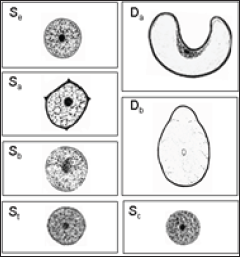
There are seven very key typical types that are identified: embryogenic cell (Se), conservative cell (Sa), stimulating cell (Sb), multiplicative cell (St), conservatively degenerated cell (Da), radically degenerated cell (Db), hyperactively dividing cell (Sc). (Figure1). Among them, the cell types of Se, Sa, Sb and St can be changed into each other by self or artificial regulation, and they also can be degenerated to the long curved (Da) or expanded (Db) cells in opposite directions (Figure 2). The Sc cell looks very similar to the St Cell, but gained a hyperactive dividing capability beyond the normally control. The other cell types are the transitional states of these typical types. When a callus is consist of many hyperactively dividing cells or conversely contains too much degenerated cells, it will not regenerate any plant.
Figure 2: The changing pattern and the relationship of different cell states. The S cell can be developed to all kinds of cells via cell division. Both Sa and Sb, cells can still divide with some degrees of differentiation in opposite directions. They formed the specialized tissues with different functions. The St Cells, like stem cells, have strong dividing capability responding the rapid growing and wound repairing. These four kinds of cell states are interchangeable, and they can be degenerated to long curved (Da) or expanded (Db) cells, and they also can be mutated/stressed into Sc cells (with hyperactively dividing capability out of the normal control of organism, eg. canceration) as showing in this diagram. What shown in dotted line direction has not been fully implemented. Note that except for Da, Db and Sc, all of the four cell states (Se , Sa , Sb and St ) allow the successful tissue and cell culture. And when the directions of the dotted lines have been fully realized, cancer will be conquered.
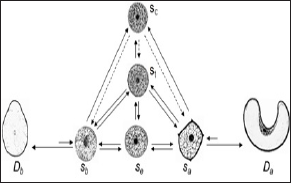
When a callus is mainly composed of conservative cells, it will regenerate plants via organogenesis. When a callus is mostly composed of the cells between the stimulating and the conservative states, it will regenerate plant via somatic embryogenesis (Figure 3). The trick of plant cell culture is to regulate the states of cells in culture. Similarly, the state of cells in a tissue determines the state and the features of the tissue which in turn decides the state of the related organ and even the whole organism. In an organism, between cell and cell, tissue and tissue are also interactively influencing and regulating their respective states. So cell state regulation also can be used in controlling the state of an organism. The cell state here is a comprehensive reflection of the composition, structures, morphology, functions and potentials of a cell.In this hypothesis, every cell has its state which is abstracted as being controlled by a series of "cell state factors".
Figure 3: Some common types of cells and calli of wheat. The pictures are taken from calli induced from immature embryos of wheat under microscope and stereoscope. a and b, the degenerated cells from the surface of calli of A and B, respectively. c and e, the cells from the calli of C and E, respectively. d, the cells in a slice of callus D. Shown inside Petri-dishes is shoot regeneration from different types of callus.
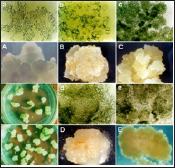
Figure 4: The roles of cell state in a living system. Biotic or abiotic hinge on whether there is a system of substances with "cell structure", which minus entropy is formed and itself boomed in nature dominated by the first and second laws of thermodynamics. The formation of biotic depends on whether this kind of unique system is formed by its substance composition and the comprehensive effects of chemistry and physics. In this system, the steady and regular programmed activities (including network communication) determined by structures is the foundation of genetics, whereas the dynamic and regular programmed activities belong to physiological phenomena. If the structures determining the steady and regular activities are changed by physiological influences, genetic variations will appear. This is the secret of evolution. The cell state is determined by genetic and physiological factors and affects the state and quality of an organism.
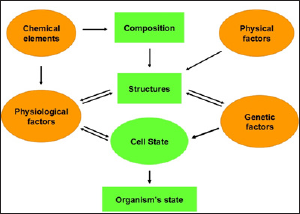
These factors include the elements not only in genetics and physiology, but also in chemistry, physics, composition and structures (Figure 4). No matter where the factors come from, their roles can be imagined or concluded as having physiological and biochemical effects. All the factors can be divided into three categories: stimulating factors (E), conservative factors (I), and degenerate factors (D). The E factors mainly promote or maintain the cell at a stimulating state. They usually promote cell division. While I factors chiefly make or keep the cell at a conservative state. They often induce cell differentiation and metabolites production. Life activities are based on the existence of E and I factors. It is that these two kinds of factors supporting and pushing the cell cycle. Both of these two factors can be further classed into internal and external types. The internal factors include the relevant genes, endogenous active substances, the effects of cell structures and their change. The external factors can be considered as all the exogenous elements. The D factors accumulated in the cell can show some similar effects as I factors when at low level, but their nature is to damage the cell structures and to disturb or injure the cell activities. The mechanism of cell state can be expressed in a formula as below:

S represents the cell state coefficient (abbreviated as S value).
Σ denotes the total value of the same type of factors.
[ ] means the level of the composite effects of the same kind factors
Figure 5: Balance model of cell state regulating. The cell state can be understood as a balance controlled by the levels of [ΣE], [ΣI] and [ΣD]. The size of the colored rectangles shows the levels of the related cell state factors ( E0 - light green, Es - dark green, I0 - light red, Is - dark red, D - brown ), and the force to the fulcrum of the balance reflects the cell division potential or capability. Different balances figuratively express the different cell types. Cells can be divided into balanced and unbalanced groups. Zygote is at the state when [ΣE0 ] / [ΣI0] = 1 it is the almighty cell. Se and St in this diagram, shown the successful culture to the wanted states, while Sa , Sb shown the cell states which cell division are not fully induced. Sc shown the typical state of canceration, while Da and Db shown the typical degeneration oppositely. The initiation and improvement of cell division are to make the S value to S or S , and the e r differentiation is to make the cell state unbalanced, to make the S value to Sa , Sb in opposite direction, or even to Da and Db.
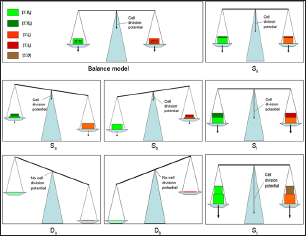
Cell division capability can be controlled by regulating S value. Cell divides when S = 1 or S≈1. When S value is close to 1, the higher level both of [Σe] and [Σi], the stronger the cell division, but when S value is away from 1, the cell must be at differentiated state or even to degenerated state. These changing can be figuratively expressed as a balance, and each typical cell can be expressed as a relevant and specific balance (Figure 5). To analyze the cell division potential and make comprehensive evaluation, it should refer to this Formula:
Dp = St [ΣE0 + Σl0 + Σ Es + Σ ls + ΔZD] (2)
Dp: cell division potential.
S1 cell division potential coefficient. When S≤1, Si=1/S; and when S<1, Si =S.
ΔΣD : The increased ΣD but cannot give cells lethal damage.
In most cases, auxin and reduced nitrogen can be regarded as Es factor-substances; cytokine, oxidized nitrogen can be used as Is factor-substances; and substances or self-metabolites harmful s’to the cells can be listed as D factor-substances. Dark treatment performs E factor effects, while light treatment shows I factor effects. In addition to providing multiple nutrients to the culture, medium also has the effect of regulating cell state based on its components. Generally, MS or AA medium usually show the effect of increasing the S value of the cultures, and are suitable for culturing the types whose S value is easily lower than 1; while N6 or B5 medium often play the effect of decreasing the S value of the cultures, and are suitable for culturing the types whose S value is easily higher than 1.
Figure 6: The dolphin-like distribution of different cell states. The changes of cell state follow the dolphin-like distribution instead of a linear distribution. The Db and Da states are distributed in the head and the tail, respectively, while Se is in the abdomen and Sc is in the back. According to the cell state formula, when the S value of the cells moves far away from 1, the cells are more likely in the degenerated states and thus less likely to divide. The cells in the head or tail (Da and Db) are no longer dividing. However, if the S value of the cells approach 1, the cells are more likely to divide, but the closer the cell states to the back of the dolphin, the stronger dividing the cells shown, the more difficult their dividing capability can be controlled. It should be considered that the values of the dividend and divider of the formula represent the level of corresponding factors and relate to the capacity of cell division.
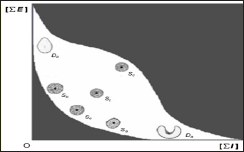
For the variation range of S value, different cell states distribute in a dolphin-like diagram (Figure 6). According to this diagram and the formulas or the balances mentioned above, and the understanding of the functions about the chemical and physical elements to the cells, the cell states of cultures can be successfully regulated towards the desired position. Hence, with the knowledge, plant tissue and cell culture can be manipulated and managed by ratiocination like using Mendel's law to guide biological breeding. And these findings also provide referential ideas to improve animal cell culture. In particular, The Cell State will provide new insights to reveal the occurrence and control of degenerative diseases such as aging and canceration. All the degenerative diseases are occurring in cells. There are many similarities between animals and plants at the cellular level.
Factors affecting cell state include all kinds of cell state factors and also the cell division latest occurred, because when a cell divides it can subvert the state from the original. In this hypothesis, E and I factors are the basis of living phenomena, but D factors usually play the tragedy maker in the living processes. In an organism, where D factors heavily accrue, the cell will goes to aging or even death. Therefore, the explant used for cell culture should be chosen as young as possible. However, D factors can also be accumulated in cells during culture, especially in a long duration culture. As the years grow, a similar situation would occur in an organism. When D factors accumulated where there are a lot of cells having strong evolutional capability, cell types with hyperactively dividing potential will be selected out by its the stress.
Only when the cell changed to this kind of type, it can dilute the degenerate substances in the cell and maintains the S value as a living cell should have via cell division. This should be the mechanisms of canceration which have not been revealed yet and the reason of Sc cells appearing. The more important cause leading to canceration in an organism is the accumulation of D factor- substance. With the stress/selection effects of D factors, gene mutation will be performed and the balance of genes expression will be broken. And along with the accumulation of D factor-substances, cell activity will be disorder, and the stress action of D factor will select out the hyperactively dividing cells which its corresponding gene mutations and gene expression balance changes will in turn support its super division capability.
The subculture approaches in plant cell culture never give the cells equal opportunities to develop, the strong dividing type will always be aggressive and getting more and more, so the cultures finally will be changed into vigorous growing types. In this situation, the differentiation approach successfully used before will not work as effective as original, high level of I factor-substances should be used to slow down the vigor of the cultures in one or several times of subculture and then to select the compact clusters from them to regenerate plants. Subculture plays a very important role in cell state regulating in cell culture. Before protoplast isolation, the cells should be regulated to strong dividing types, which the protoplast will be easy to isolate and culture. But for the regenerated callus from protoplast or callus induced from microspore, they are usually growing too vigorously and difficult to regenerate plant.
To deal with this kind of problems, the cell state should be regulated to Se type. The large scale cell culture also can be managed by cell state regulation, when the cells are needed to growing quickly, their state should be regulated to St Type, but when the cells are wanted to produce more secondary metabolism products, the cell state should be regulated to Sa or Sb types. For plant cells it can be completely and artificially regulated, and for animal cells it should be confident that it will go to the same extent in future. For an organism, medical treatment is like a kind of subculture to its in vivo cells. The point of view to analyze and control cell state is very referential to human health care. Life span will be very significantly impacted by the speed and the amount of D factors accumulation in the development of an organism. Reducing the content of D factors will lead the organism to a better result for leaving aging and lesion.
Aged creatures will be restored or rejuvenated at a certain extent if the D factor-substances can be eliminated (Figure 7). Most of all, cancer will be no longer occurred when D factor substances are controlled and reduced to nonentity. For organisms, the most important discovery is the presentation of the concept of D factor. All degenerative diseases are related to the production and accumulation of D factor-substances. The reason why cancer gene therapy cannot finally be consolidated is that D factor- substances still exist. In an organism, as long as D factor-substances have accumulated to a certain level, canceration will become an inevitable event. Even if the cancerous gene expressions are all blocked, and ultimately there will be other genes corresponding mutations occur, but to different gene therapy, cancer recurrence interval will be different.
Figure 7: The hypothetical cell state regulation model for the control of lesion. In this model, the cells in or close to the abdomen (Sa, Sb, Se, even to St) are juvenile andhealthy. They not only have dividing capability but alsocan be controlled easily. The Se cells in particular do notshow any degenerate signs. Successful efforts to make thestates of the cells to approach the abdomen will reverse the cancerous and aging.
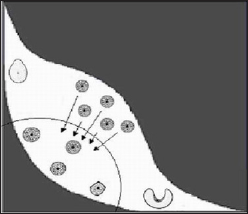
The causes of degenerative diseases are due to the accumulation of D factor-substances, to prevent diseases needs to eliminate D factor-substances, to consolidate the effects of medical treatment including gene therapy of cancer also needs to eliminate D factor- substances. In many cases, a healthy recovery is the elimination of D factor-substances in the body. The traditional method to treatment cancer is to kill the actively dividing cells, and the medicines to kill cancer cells are also belong to the D factor-substances. Why the recurrence of cancer is so quickly, the reason is the toxic side effects of the medicines used which they damage the immune system and the normal cells and induce more cancerous cells and make the cancer becomes more malignant. Therefore, this kind of treatment of cancer will certainly make patients embark on no return.
As cancer cells usually produce a large number of growth factors, the proliferation of these factors can make cells more susceptible to cancer in the presence of the D factor-substances. In plant cell culture, it is often to use the cells with strong dividing ability to nourish and promote poorly dividing cells. Effective cancer treatments should not only paid attention to prevent the division of cancer cell and block the production of growth factors which inducing cancerous, but in the meantime it is also necessary cooperated with eliminating the D factor-substances. Only in this way, it can premise no recurrence of cancer, because without D factor-substances, there are no longer stress conditions selecting out of cancerous cells. A previous article reported that cancer is caused by unavoidable DNA replication errors [3]. It initiates a discussion about the etiology of cancer. In fact, there is a serious misunderstanding.
DNA replication errors occur in cell division, and the more times of cell division the more prone to genetic variation. However, the occurrence of genetic variation is not necessarily cancerous, only in the presence of D factor-substances can cause cancer. Cancerous looks very like a result of mutation, but it actually developed from the survivals of the stress and selection by D factor-substances. The reason why the incidence of cancer is positively related to age is that the more D factor-substances are absorbed and accumulated in the tissues of the organs with age increasing. Senescence is a result of direct disruption of cells and tissues by D factor substances, and cancer is a result of the stress and selection of D factor to many DNA replication errors. Other degenerative diseases are the different states of tissue and organ caused by D factor in cell which they are between at aging and canceration. Why some children suffered from cancer, it is due to the intake of D factor-substances at embryonic development stage or even earlier. It is that D factor-substances are the base reason of cancer. To p. revent cancer, it must be paid attention to control the harmful substances inside or outside of the body. In conclusion, preventing the accumulation of D factor-substances in the body or eliminating it will render the organism neither old nor prone to cancer and other degenerative diseases. This should become the fundamental basis for disease prevention and treatment.


